
Desilu Productions was an American television production company founded and co-owned by husband and wife Desi Arnaz and Lucille Ball. The company is best known for shows such as I Love Lucy, The Lucy Show, The Untouchables, Mission: Impossible and Star Trek. Until 1962, Desilu was the second-largest independent television production company in the United States, behind MCA's Revue Studios, until MCA bought Universal Pictures and Desilu became and remained the number-one independent production company, until being sold in 1968.
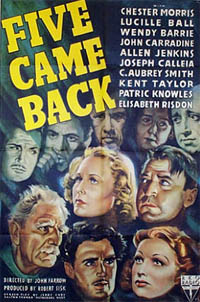
Five Came Back is a 1939 American black-and-white melodrama from RKO Radio Pictures produced by Robert Sisk, directed by John Farrow, written by Jerry Cady, Dalton Trumbo, and Nathanael West, and starring Chester Morris and Lucille Ball. The film was photographed by cinematographer Nicholas Musuraca. Although considered a B movie, the positive notices received by Ball helped launch her career as an A-list actress. Five Came Back is considered a precursor of the disaster film genre. The supporting cast features Wendy Barrie, John Carradine, C. Aubrey Smith, Kent Taylor, and Patric Knowles.
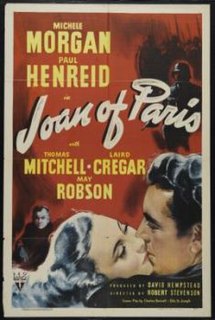
Joan of Paris is a 1942 war film about five Royal Air Force pilots shot down over Nazi-occupied France during World War II and their attempt to escape to England. It stars Michèle Morgan and Paul Henreid, with Thomas Mitchell, Laird Cregar and May Robson in her last role.

Flight from Glory is an American B movie about a run-down air cargo company in the Andes. It was directed by Lew Landers, and starred Chester Morris, Whitney Bourne, Onslow Stevens and Van Heflin. When released on August 20, 1937, Flight from Glory was considered one of the films that broke new ground in "pioneering airline sagas", comparing favorably to big-budget features such as 1936's Thirteen Hours by Air.
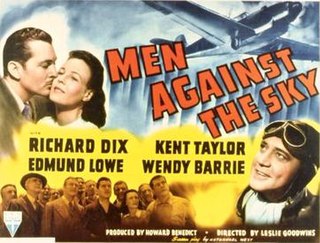
Men Against the Sky is a 1940 drama directed by Leslie Goodwins and starring Richard Dix, Kent Taylor, Edmund Lowe and Wendy Barrie. Based on a story by John Twist, with a screenplay by novelist Nathanael West, the film is about aircraft development and the dangers of flying in the period before World War II.

Isle of Destiny is a 1940 American comedy adventure film set in the South Seas. The film was directed by Elmer Clifton and originally produced by Franklyn Warner for Grand National Pictures in 1939. Isle of Destiny was the only feature film filmed in the Cosmocolor process with prints by Cinecolor. Isle of Destiny stars William Gargan, Wallace Ford, June Lang and Gilbert Roland.

Look Who's Laughing is a 1941 film from RKO Radio Pictures. The film is built around a number of radio stars from the Golden Age of Radio and centers around radio personality Jim Jordan as Fibber McGee from the comic duo, Fibber McGee and Molly, who plans to build an aircraft factory in a small town. Look Who's Laughing was followed by Here We Go Again (1942), with many of the radio stars reprising their performances.

The Lost Squadron is a 1932 American pre-Code drama, action, film starring Richard Dix, Mary Astor, and Robert Armstrong, with Erich von Stroheim and Joel McCrea in supporting roles, and released by RKO Radio Pictures. Based on the novel The Lost Squadron (1932) by Dick Grace, the film is about three World War I pilots who find jobs after the war as Hollywood stunt fliers. The much-later The Great Waldo Pepper (1975) employed a similar theme. The Lost Squadron was the first RKO production to carry the screen credit "Executive Producer, David O. Selznick".

The Holy Terror is a 1937 American film directed by James Tinling as a vehicle for child star Jane Withers. The film follows the comic adventures of 11-year-old Withers as she causes mild havoc and catches spies on her father's naval base.

Sea Devils is a 1937 American film directed by Benjamin Stoloff. Among the American "preparedness films" of the mid-1930s devoted to enhancing the image of the Army, the Navy and the Marines, this entry focuses equivalent approving attention on the work of the U.S. Coast Guard.

RKO Radio Pictures, Inc., commonly called RKO Pictures or simply RKO, was an American film production and distribution company that was one of the "Big Five" major film studios of Hollywood's Golden Age. The business was formed after the Keith-Albee-Orpheum (KAO) theater chain and Joseph P. Kennedy's Film Booking Offices of America (FBO) studio were brought together under the control of the Radio Corporation of America (RCA) in October 1928. RCA chief David Sarnoff engineered the merger to create a market for the company's sound-on-film technology, RCA Photophone. By the mid-1940s, the studio was under the control of investor Floyd Odlum.
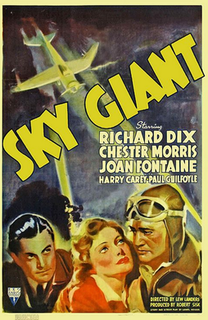
Sky Giant, also known as Ground Crew and Northern Flight, is a 1938 drama film directed by Lew Landers. The film stars Richard Dix, Chester Morris and Joan Fontaine. The plot revolves around a love triangle with two pilots in love with the same woman.
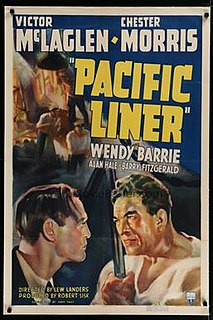
Pacific Liner is a 1939 American action/adventure film directed by Lew Landers. The film stars Victor McLaglen, Chester Morris and Wendy Barrie. Pacific Liner is primarily set in the engineering section of the vessel, where a stowaway has infected the crew with cholera. While passengers remain oblivious, the ship’s doctor (Morris) and nurse (Barrie) work to control the infection and heal their patients while the engineer (McLaglen)—who scoffs at “bugs”—keeps the stokers at their jobs filling the ship’s boilers with coal to make the best time to San Francisco.
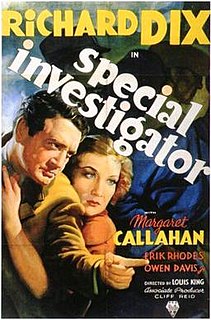
Special Investigator is a 1936 RKO Radio Pictures American crime-drama film, starring Richard Dix and featuring Margaret Callahan, Erik Rhodes and Owen Davis, Jr. It was directed by Louis King from a screenplay by Louis Stevens, Thomas Lennon and Ferdinand Reyher, based on "Fugitive Gold", a story by Erle Stanley Gardner originally serialized in the New York Herald Tribune's This Week magazine from May 26–July 7, 1935.

Flying Devils is a 1933 American Pre-Code action film dealing with aviation. The film was directed by former Hollywood agent Russell Birdwell and photographed by film noir cinematographer Nicholas Musuraca. The screenplay was written by Byron Morgan and Louis Stevens, based on an original story by Stevens. In an unusual move, Bruce Cabot was the star, with perennial "good guy" Ralph Bellamy playing the villain in a love triangle involving Arline Judge and Eric Linden. Although considered a "B" feature, audiences enjoyed the aerial scenes, which helped elevate the feature to a minor box-office hit.

Daredevils of the Clouds is a 1948 American drama film directed by George Blair and produced by Republic Pictures. The film stars Robert Livingston, Mae Clarke and James Cardwell. Daredevils of the Clouds depicts bush pilot flying in northern Canada.

Frank Redman was an American cinematographer from the end of the silent era through the 1960s. During his almost 40-year career, he shot over 60 feature films, as well as several film shorts and serials. In the 1950s, he transitioned to the smaller screen, where he was most well known for his work on the iconic television show, Perry Mason from the end of the 1950s through 1965.

Wings Over the Pacific is a 60-minute 1943 drama film, directed by Phil Rosen and starring Inez Cooper, Edward Norris and Montagu Love. Produced by Monogram Pictures, the film depicts an island community in the South Pacific caught up in World War II.

Canal Zone is a 1942 American aviation adventure film starring Chester Morris and Forrest Tucker. The action takes place in the Panama Canal Zone and revolves around aviators in an out-of-the-way air base flying U.S. Army bombers.

Adrian Michael Morris was an American actor of stage and film, and a younger brother of Chester Morris.




















